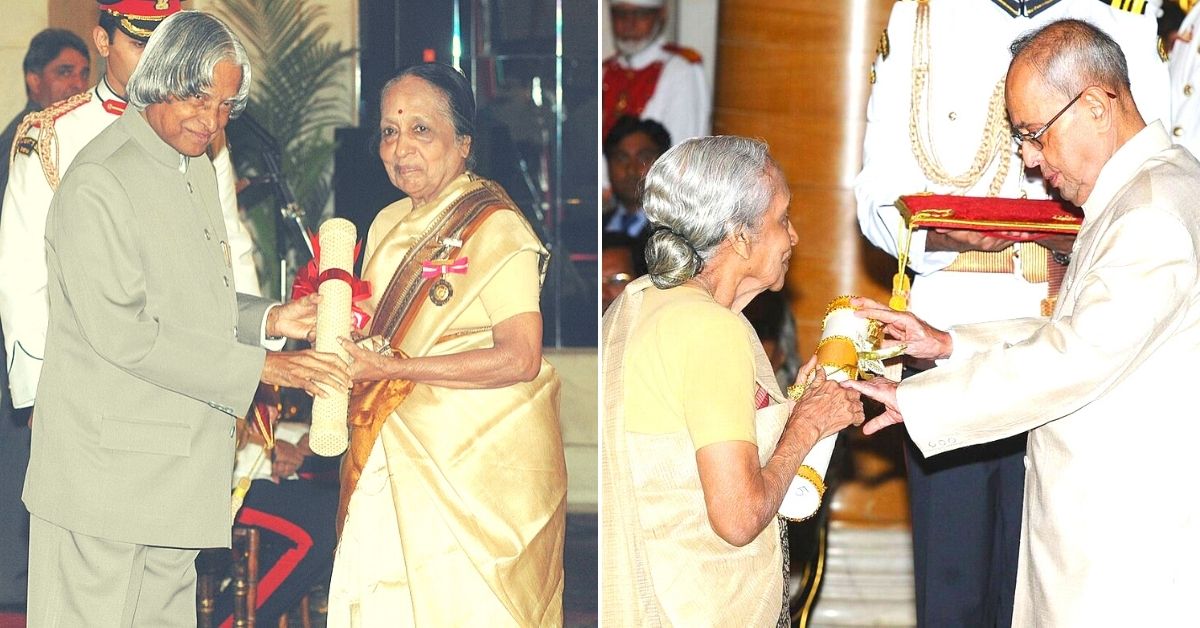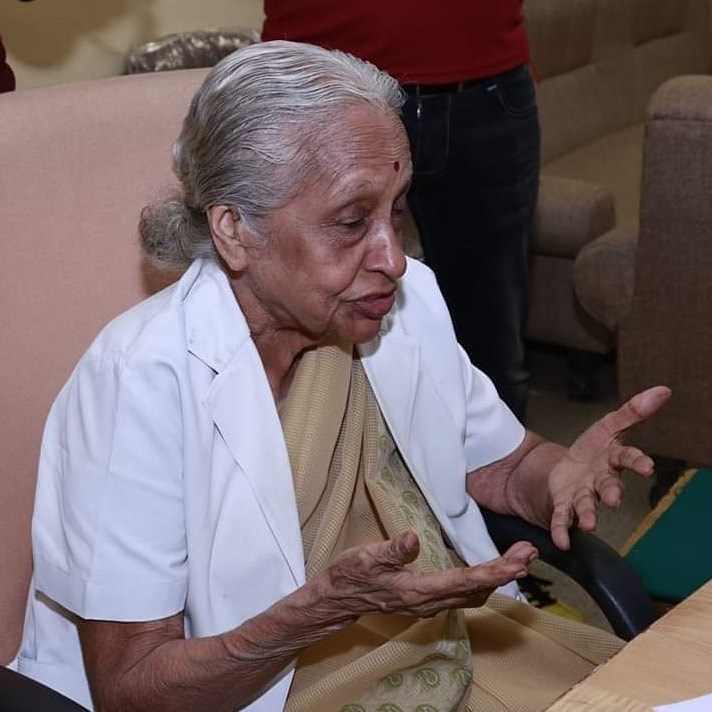In Tribute: Padma Bhushan Doctor V Shanta, Who Helped Make Cancer Care Affordable
Humanitarian and extraordinaire, Dr V Shanta was an oncologist and a pioneer in cancer care in India. Steering the Cancer Institute (WIA), Adyar in Chennai to iconic status, she breathed her last on January 19. She was 93.

Dr V Shanta, a pioneer in cancer care in India who headed the Cancer Institute (Women’s India Association), in Adyar, Chennai, passed away early morning on 19 January 2021 at the age of 93. She joined the institute as only one of two doctors in 1954, alongside Dr. S. Krishnamurthi, the son of Dr. Muthulakshmi Reddy—the first woman medical graduate in India, first Indian woman legislator and the institute’s founder.
“I jumped at the opportunity and joined the Institute. It was truly a turning point in my career, and it was made possible by the indomitable courage of Dr. Reddy. She not only struggled to establish the Cancer Institute, but she was a tireless social worker who fought for the emancipation and empowerment of women. She was a legend in her lifetime,” said Dr. Shanta,” in a conversation with ASCO Post, an online publication, in January 2019.
After working for a year on a voluntary basis, she joined the Cancer Institute (WIA) as a Resident Medical Officer on 13 April 1955 and remained there all her life.
She played a pivotal role in transforming a 12-bed cottage hospital in the 1950s into a 500 plus bed facility today, providing quality affordable care, world-class facilities and subsidised treatment to the underprivileged, based on an income-based differential payment system.
Backed by Dr. Krishnamurthi, she instituted the practice of ethical care for the underprivileged where 30% of the patients are boarded, lodged and treated free of cost.
‘I Was The Nurse And The Surgical Assistant’
Born on 11 March 1927, Dr. Shanta came from a family of high achievers, which included Nobel laureates Sir CV Raman and Subrahmanyan Chandrasekhar. Despite the emphasis on educational excellence in the family, very few women of her generation considered a career in medicine. By the time she was 12, she had decided to become a doctor inspired by her mother’s life as a care-giver in the family.
However, there was a stark difference. “I wanted to be independent; [but] my mother had spent too much time taking care with nothing to fall back upon,” said Dr. Shanta to Kamala Ganesh, a Mumbai-based sociologist, according to an article she wrote titled ‘Healing Touch: Dr. V. Shanta’s Journeys in Cancer Treatment and Care’ published in Feminists and Science: Critiques and Changing Perspectives in India (Volume 2).
After obtaining her MBBS degree in 1949 from the Madras Medical College, she went on to complete her MD in gynaecology and obstetrics six years later. In the interim, however, she first interned at the Cancer Unit of the Government General Hospital in Chennai, where she met Dr. Krishnamurthi for the first time in 1950.
Under the influence of his early mentorship, she was convinced to make the change from gynaecology and obstetrics, which most women in the medical profession opted for then, to oncology. Barely a year after joining the Cancer Institute, she went to Toronto, Canada, to train in oncology and studied advanced cancer care in the United Kingdom in the 1960s.
“Cancer treatment at that time was done by general surgeons and physicians. At the time of its founding, the Cancer Institute had only two doctors—Dr. Krishnamurthi, who was trained in surgery and tumor pathology, and me. I was a gynecologist and had trained in radiation oncology at the Princess Margaret Hospital in Canada. Between the two of us, we managed surgery, radiotherapy, and pathology. Medical oncology and chemotherapy were born years later, around 1970,” she told ASCO Post in a January 2019 interview.
She would sterilise and clean the operating theater herself after a procedure because of the lack of trained personnel and the Institute did not have a full-time anesthesiologist.
“We often started operating at 8:00 PM or 9:00 PM and finished past midnight. I would serve as the nurse and the surgical assistant. After grouping and cross-matching, I started the blood transfusion, assisted the anesthetist in getting the anesthesia going, scrubbed and laid the table, draped the patient, and assisted with the operation. Radiation therapy was carried out in the mornings, and the histopathologic work was done in the afternoons,” she added.
This was at a time when cancer was a disease largely seen as fatal or ordained by fate with no escape from it. As a doctor in South India’s first specialised hospital for cancer, she would spend her years enhancing the access of underprivileged persons afflicted by cancer, strengthen prevention, early treatment and quality of patient care, and develop systems at the hospital that went much beyond medical treatment.
At the start of her career, a large segment of the patients presented cancer at an advanced stage. Although the Institute has made significant progress in early-detection strategies thanks to her yeoman service, Dr. Shanta believed that there was a lot more work ahead.
She did all of this while battling public apathy, hurdles set by bureaucratic institutions, political leaders and constant shortage of funds. Balancing the requirements of quality care and affordability, the institute pioneered medical, surgical and radiation oncology in India.

A Cancer Institute of Firsts
Kamala Ganesh notes in her article, ‘Healing Touch: Dr. V. Shanta’s Journeys in Cancer Treatment and Care’:
There were many other firsts: The Institute started a department of nuclear medical oncology in 1957, introduced radioactive isotopes in diagnosis and treatment, acquired the Cobalt 60 unit in 1957 (the first in South and Southeast Asia), the first Indian-built X-ray Therapy Stimulator in 1969, and in 1976, the Linear Accelerator, a High Energy X-ray machine more advanced than Cobalt 60. It started specialised academic courses from 1960 through Madras University and later by establishing the Dr. Muthulakshmi College of Oncological Sciences, attached to MGR University, the first such in India.
That is not all. The Institute has contributed to mapping the course, spread and control of the disease through a Hospital Cancer Registry. From the start, protocols were developed for keeping detailed patient records, with a formidable follow-up system. On occasion, the Institute was known to send its personnel to track a recalcitrant patient to his village and escort him physically for follow-up! In a largely illiterate population, this reduced fatalities considerably.
Besides, the Cancer Institute worked very closely with the government to offer things like concessional travel for cancer patients (1956) and declaration of anti-cancer drugs as life-saving and removal of licence and custom duty on imported chemotherapy drugs (1971).
Under Dr. Shanta’s leadership, the Institute drummed up many international scientific collaborations with the funds generated used to strengthen laboratory facilities, enhance cancer treatment protocols and train its doctors in the West. Moreover, it was at her insistence that Tamil Nadu government first began screening women for cervical cancer.

Her Model of Care
For Dr. Shanta, empathy and compassion stood at the heart of her practice. A physician’s role, she believed, went well beyond the treatment table and gave her patients all she could.
“Care is caring for the individual – like what you would do for your mother or father or son or child. It is a question of communication with the patient… The physician is not just a doctor but should become part of the family… Unfortunately, there is a stigma attached to cancer. Care means dealing with that as well….You must be part of them… In the end, when they are dying, people don’t want anything. They only want someone there to take care of them. When they are not so ill, we have to prepare them gently. Here we need trained counsellors. Medical personnel are not enough…Even when there is no hope, you have to give some message of hope to sustain them. It is a hard thing,” notes Dr. Shanta.
On breaking bad news to patients, here is what she told Women’s Feature Service:
“When people ask me this question [whether they can be cured or not] I have to take a very sensitive approach. There are times when I can emphatically say yes. But in situations where the odds are not looking good, I try to couch my answer in terminology that gives some hope. The toughest is when someone comes to us in the advanced stages; it becomes very difficult to convey to them for how long they will live,” she says.
Dr. Shanta’s compassion, empathy and dedication towards building up an institution like the Cancer Institute was what won her the Ramon Magsaysay Award (2005), Padma Bhushan (2006), the third highest civilian honour in India and Padma Vibhushan (2016), the second highest civilian honour, besides finding a place in the WHO (World Health Organization) Advisory Committee on Cancer till March 2005.
But not one for resting on her laurels, she continued working at the Institute even in her 90s. During the recent COVID-19 pandemic, despite failing health, she still worked.
“As far as patient care is concerned, India has attained global standards and our therapeutic facilities match the best in the world. However, initially we were a little slow in providing priority care. Moreover, the fruits of research are taking longer to reach us because of financial constraints. But I firmly believe in the mantra that treatment must be equitable for all patients, rich or poor. Unfortunately, the corporatisation of the medical world has changed the ethos and also widened the rural-urban divide,” she told the Women’s Feature Service.
(Edited by Yoshita Rao)
Like this story? Or have something to share? Write to us: [email protected], or connect with us on Facebook and Twitter.

Similar Story

3 Friends Are Taking ICUs to Rural India With a Simple Kit & An Innovative Idea
Dr Ashwin Naik, Maanoj Shah, and Dr Edmond Fernandes initiated ‘Mission ICU’ to bring critical healthcare services to rural India. They achieve this by equipping hospitals with essential equipment so patients don’t have to travel long distances for medical care.
Read more >
If you found our stories insightful, informative, or even just enjoyable, we invite you to consider making a voluntary payment to support the work we do at The Better India. Your contribution helps us continue producing quality content that educates, inspires, and drives positive change.
Choose one of the payment options below for your contribution-
By paying for the stories you value, you directly contribute to sustaining our efforts focused on making a difference in the world. Together, let's ensure that impactful stories continue to be told and shared, enriching lives and communities alike.
Thank you for your support. Here are some frequently asked questions you might find helpful to know why you are contributing?


This story made me
-
97
-
121
-
89
-
167












